Bhagirat, a Gond Adivasi, eagerly guided me through his fields to showcase the solar light trap device he uses on his farm. Patna village, located in the Jharkunwa Gram Panchayat, about 3 kilometres off-road from Bijawar block in Chhatarpur district, is home to 530 residents. The villagers here primarily rely on agriculture for their livelihood.
As I travelled from Bijawar to Patna, passing through the dense forests of Panna Tiger Reserve, the terrain shifted from flat roads to hilly landscapes, and the villages grew increasingly remote. Bhagirat’s village is one where the nearest hospital is about 15 kilometres away. In case of an emergency, hiring a vehicle to transport a patient costs at least 800 rupees. Enduring power cuts, water shortages, and lack of proper roads, the villagers live in kachha houses, pinning all their hopes on their agricultural yields.
Facing drought-like conditions in the summer and heavy rainfall this month, the farmers in the village are under constant pressure to protect their crops. Adding to their worries is the growing problem of pest infestations. Last year, they received solar light traps distributed by the ICICI Foundation.

“We conducted an awareness drive for farmers across villages in Bijawar block and distributed these devices at a cost of Rs. 279 to the farmers,” informed Sachin Khare co-ordinator at ICICI foundation.
What are solar light traps?
Solar light traps are an innovative, eco-friendly solution for pest control in agriculture, offering farmers an alternative to chemical pesticides. Powered by solar energy, these devices use light to attract pests, particularly at night, when many harmful insects are active. Once drawn to the light, the insects are either captured or killed by a simple trapping mechanism, such as a sticky surface or an electric grid.
“This is a trial we conducted to assess the effectiveness of these devices in reducing costs for farmers by minimizing the need for insecticides and other chemicals,” Khare added.
By utilizing renewable energy, solar light traps not only reduce the need for harmful chemicals but also help protect beneficial insects and maintain ecological balance. This sustainable approach is especially valuable for farmers in rural areas, offering a cost-effective method to safeguard crops while promoting environmental health.
Catching insects and pests
In Bhagirat’s vegetable farms, spread over 5 acres with bottle gourd, green chillies, lady fingers and sesame grown, his insect device collects insects in a part of his chilly field. These devices use blue light to attract the insects.
“We use oil and water that keeps the insects attracted to the blue bulb in the yellow tray, this oil can again be reused once we clean the tray,” Bhagirat added.
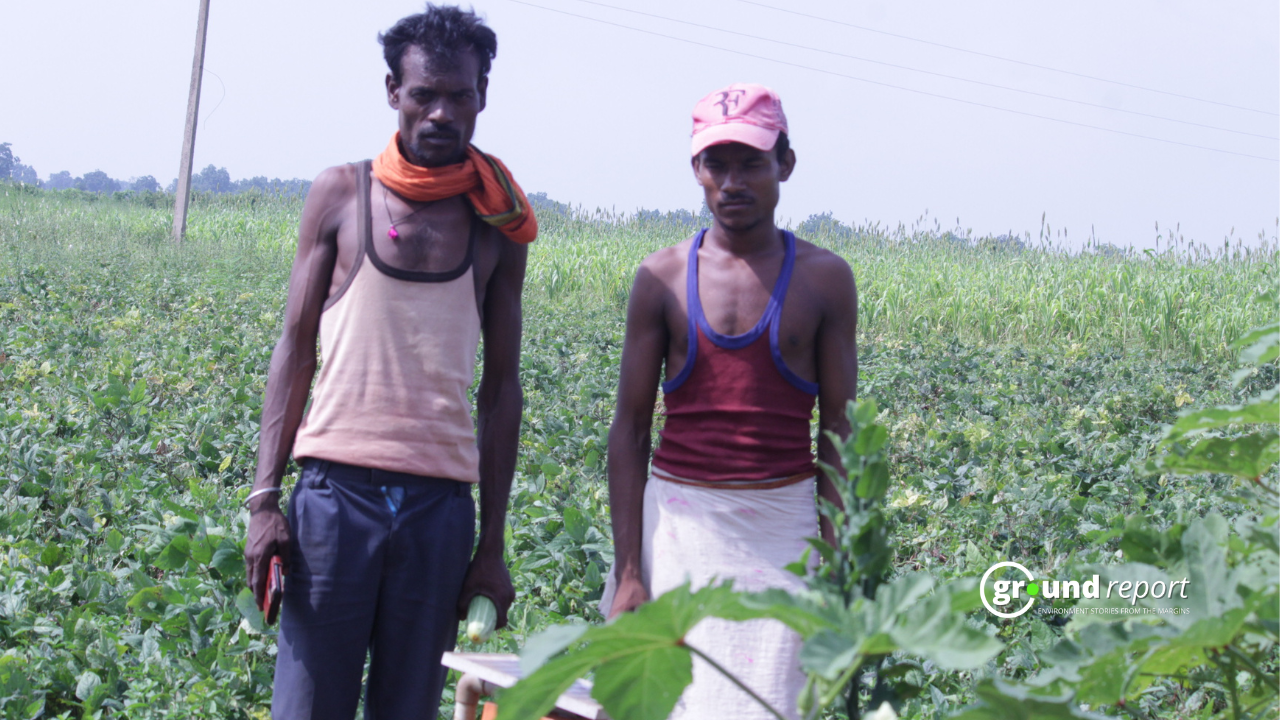
Insects are drawn to ultraviolet (UV) light primarily because many of them are naturally attracted to UV wavelengths, which are a component of sunlight. In nature, UV light often indicates the presence of flowers, which are rich in nectar and pollen. Insects like bees can see UV patterns on flowers that are invisible to humans, guiding them to their food sources.
Additionally, UV light is more intense and visible to insects compared to other light sources, as their eyes are equipped with photoreceptors that are highly sensitive to UV wavelengths. Some insects also use UV light for navigation, and artificial UV lights can mimic the UV signals of natural sources, misleading insects into approaching them as if they were potential food or mating sites.
An experiment, “Development of Eco-Friendly Solar Photovoltaic Insect Light Trap for Pest Control” was conducted to evaluate the effectiveness of three different light colours—ultraviolet (UV-A), yellow, and blue—in solar insect traps. The results indicated that the UV-A blue light trap outperformed the other two in terms of the number of insects collected. The UV-A blue light was particularly effective at attracting harmful insects. Therefore, incorporating UV-A blue light into solar insect traps proves advantageous for integrated pest management practices.
Khare explained the design of these traps. The solar light insect pest trap incorporates a 10-watt solar panel that harnesses solar energy to charge a 12-volt, 7 Ah sealed lead-acid battery during the day. The battery stores this energy and powers a 3-watt ultraviolet LED bulb at night, which emits light in the 315-400 nm wavelength range, ideal for attracting insects. A diode is included to prevent reverse current flow from the battery to the solar panel. An on/off switch allows for convenient control of the LED light.
He informed, “The trap includes a funnel with an upper diameter of 26 cm and a lower diameter of 3.5 cm, guiding insects into a collecting tub through a 5.5 cm entrance.”
The entire device is supported by a sturdy tripod or stand, ensuring stability and proper positioning of the trap.
Combining with Organic fertilizer
Ganesh, another farmer from Patna village talks about the benefits of solar light traps combined with the use of organic fertilizer. He stores wet waste from his farms, bitter and dry leaves for around 40 days to prepare the fertilizer.
“Although we have to use it twice as compared to the chemical fertilizer which works with just one use, this is still more economical for us,” Ganesh told Ground Report.
Pest control is a major challenge in field crops. While chemical pesticides are commonly employed to manage insect pests, they pose risks to human health, the environment, and biodiversity. Additionally, the frequent and prolonged use of these pesticides can lead to pests developing resistance.
Ganesh greeted me with a warm smile, offering a fresh bottle gourd from his farm. He is a firm believer in the benefits of organic farming practices, convinced that they enhance the quality of his produce. He has found that using organic fertilizers in conjunction with solar light traps is an effective method for pest control.
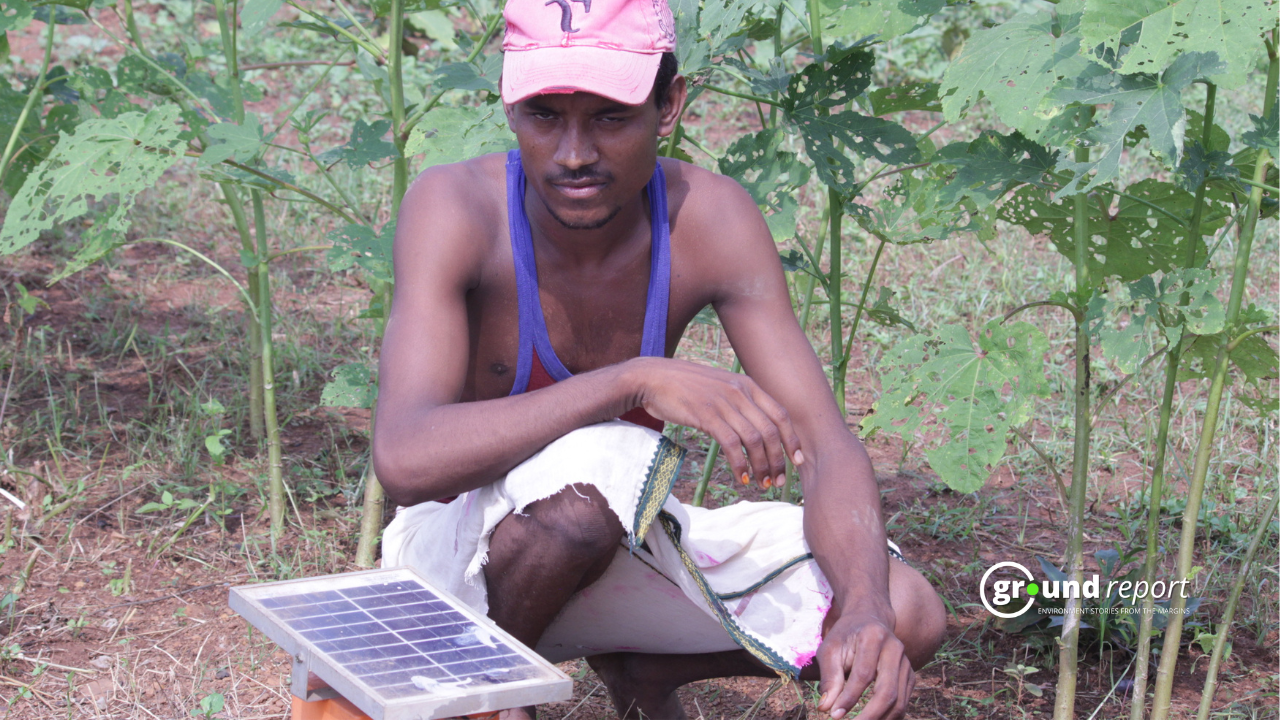
The farmers are provided these devices at approximately ten per cent rate. The device costs Rs. 2822 as informed by Khare. He suggests using one device per acre.
“The lower price encourages farmers to try the device and experience its benefits firsthand. The trial phase is designed to ensure that farmers become familiar with the device and learn how to use it easily.” Khare added.
But is it beneficial for the entire year?
While exploring Jharkunwa Gram Panchayat, I encountered a muddy road leading to a line of women and children waiting to fill their containers with water. Despite the monsoon season, this village in the Bundelkhand region was telling the same tale of water scarcity that echoes throughout many of its neighbouring villages.
I followed Kaku Bai, a tribal woman who carried water containers on her head and smiled while I was looking at her. As we reached her home, a kachha house with a roof made of mud tiles (khapra), covered with polythene to avoid water leakages.
Upon these roofs were solar light traps!
Kaku bai complained, “The intensity of these lights has diminished, resulting in fewer insects being attracted to them. As a result, we still need to rely on chemicals for effective pest control.”
And so now, she has kept the device on her roof so it can give some light during night and power cuts.
“We have observed that it is effective during rabi season, while during kharif season, the farmers complained of bulb damages. We are working to rectify the technical errors,” Khare told Ground Report.
According to a study, a variety of light traps, such as tungsten, incandescent, fluorescent, and high-pressure mercury vapour lamps, are commonly used to monitor and control insect populations. However, their effectiveness is often limited by the emission of long-wavelength light, including non-visible infrared radiation. Additionally, these traps tend to have high energy consumption, short lifespans and may contain toxic mercury.
However, these traps face limitations, particularly when target insect populations are very large, leading to oversaturation. This necessitates more extensive preparation and increased handling time in the field.
“Regular cleaning of trays and insect collectors is significant. Otherwise, the device can get ineffective,” Bhagirat informed.
Surprisingly, Sarpanch Radha Singh was not aware of the device or how the solar light traps are used. He looked with confusion at me, but when I pointed at the device in a farm, he nodded and said, “Yes, some organisation people distributed this. I don’t know how it works.”
“The farmers should be taught better about the use of the device and how it can work effectively. I believe one device per acre is an ideal set-up,” Ganesh added.
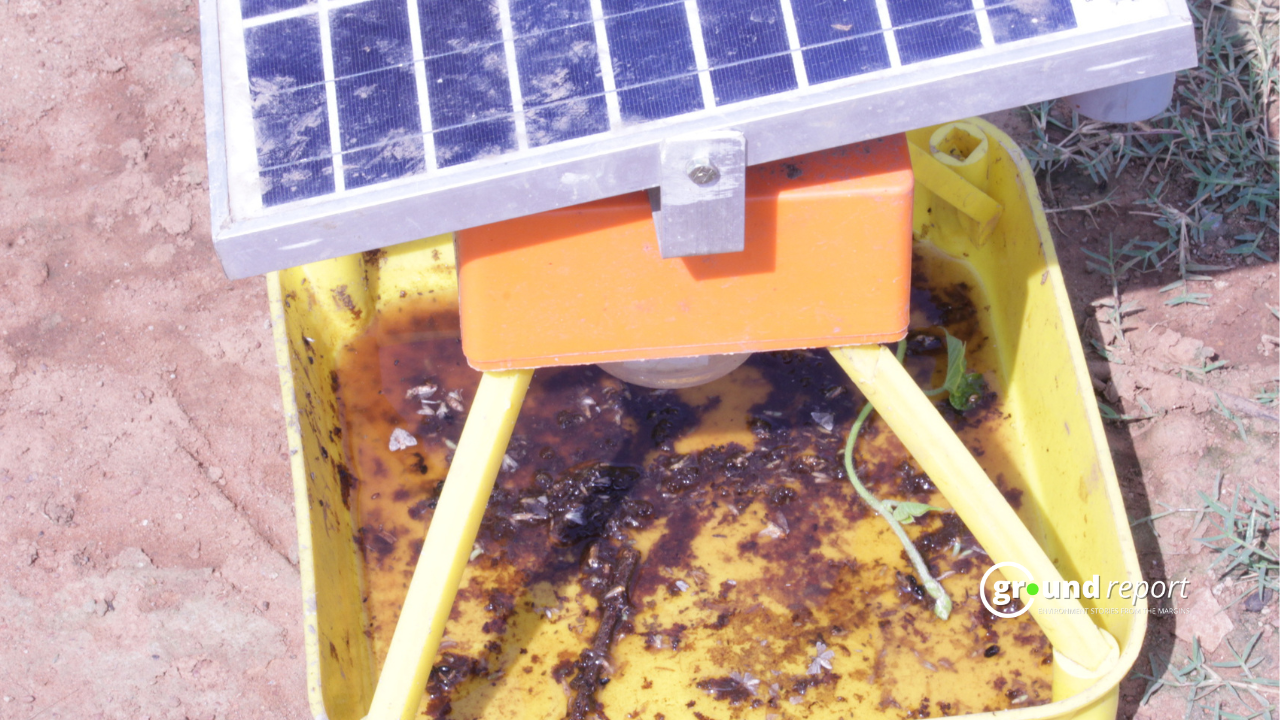
This project cost around 14 lakh rupees spread across 25 villages of Bijawar block. These villages are remote with limited access to resources and even to the main city. According to Khare, “projects like these can reduce the cost of farming in the area.”
Chemical pesticide use in agriculture
In 2022, global agricultural pesticide use reached 3.70 million tonnes (Mt) of active ingredients, reflecting a 4% rise compared to 2021, a 13% increase over the past decade, and double the amount used in 1990. Asia led pesticide exports that year, shipping 3.5 Mt valued at USD 21.7 billion, with 2.3 Mt worth USD 15.3 billion going to regions outside of Asia.
According to the Food and Agricultural Organization (FAO, 2022), India used over 61,000 tonnes of pesticides in 2020, a significantly lower amount compared to countries like Brazil (377,000 t), China (273,000 t), and Argentina (241,000 t). Despite this relatively low usage, India’s pesticide production has seen substantial growth. Between 2022 and 2023, production reached 258,130 tonnes (GoI, 2023), more than doubling from 102,240 tonnes in 1998. Currently, India manufactures 104 out of the 293 registered pesticides.
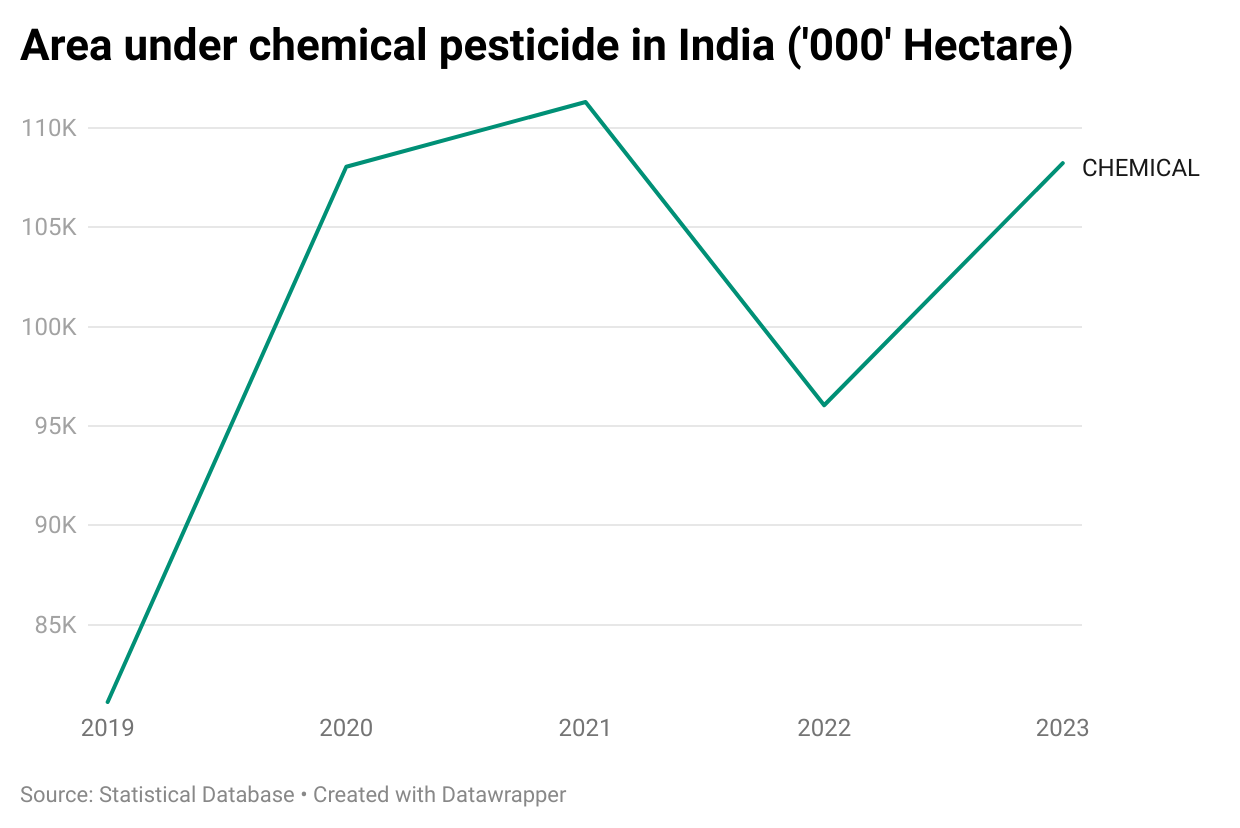
The above graph indicates the use of chemical pesticides in the country between 2018-2023. During Covid-19 peak years (2021-22), India saw a decline in the use of pesticides. However, there is an increase in the use again in recent years.
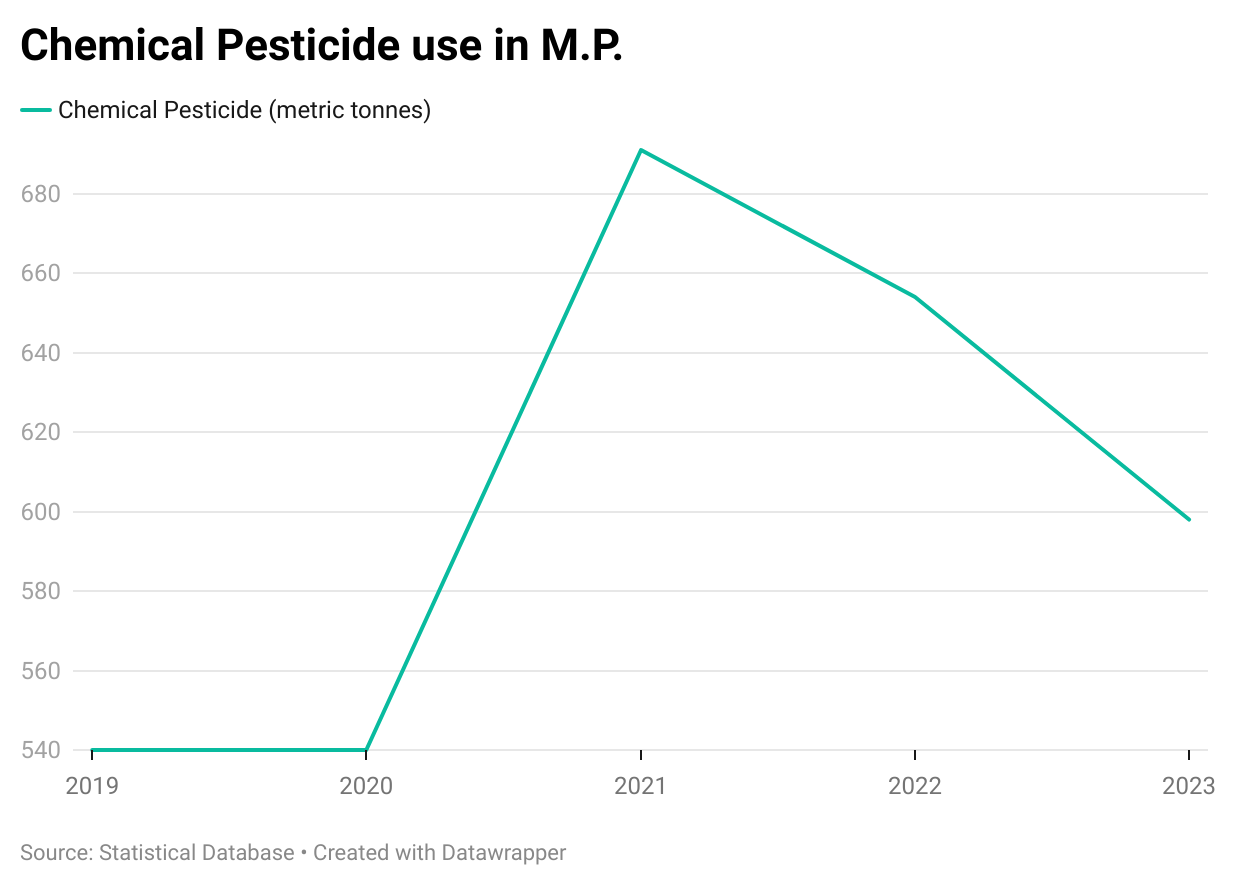
Between 2019 and 2023, the use of chemical pesticides in Madhya Pradesh has increased from 540 metric tonnes to 598 metric tonnes (MT). The year 2021 observed the highest use of chemical pesticides with 691 MT in the state of Madhya Pradesh and 111289 MT across India. On the positive side, Madhya Pradesh has noted a decline in use of overall harmful pesticides over the years. States with more advanced agricultural sectors, such as Gujarat, Tamil Nadu, Punjab, Madhya Pradesh, Haryana, Himachal Pradesh, and West Bengal, displayed negative growth rates, compared to the higher levels observed in 2004–2005. The analysis indicates a decline in pesticide consumption
Various studies have concluded that the use of these eco-friendly devices can help reduce the use of pesticides and insecticides. However, these villages in the Bundelkhand region need better maintenance to make it successful. The absence of technical support for repairs, combined with damage during the rainy season and limited knowledge, poses a significant obstacle to effective use.
Support us to keep independent environmental journalism alive in India.
Keep Reading
The costliest water from Narmada is putting a financial burden on Indore
Indore’s Ramsar site Sirpur has an STP constructed almost on the lake
Indore Reviving Historic Lakes to Combat Water Crisis, Hurdles Remain
Indore’s residential society saves Rs 5 lakh a month, through rainwater harvesting
Follow Ground Report on X, Instagram and Facebook for environmental and underreported stories from the margins. Give us feedback on our email id greport2018@gmail.com.
Don’t forget to Subscribe to our weekly newsletter, Join our community on WhatsApp, and Follow our YouTube Channel for video stories.






